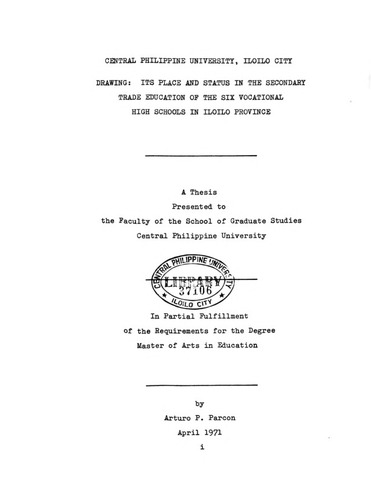Drawing: Its place and status in the secondary trade education of the six vocational high schools in Iloilo Province
요약
Drawing is recognized as highly important in carrying out successful instruction in shopwork. As a related subject, it should be taught on the basis of what drawing skills and information the students need in the type of shopwork in which they are specializing. Effective teaching in drawing can only be done when the needs of the students for their shopwork are met and enough attention is given to its financing, to the qualifications of its personnel, to the physical facilities for instruction, and to the program of instruction itself. This study attempts (1) to determine the extent to which drawing is meeting the needs of the students in the different types of shopwork required in vocational education and (2) to give a definite description of the attention given by the six vocational schools to the following decisive factors that affect the status of drawing: finance, personnel, physical facilities, and instruction.
The procedure which was followed comprised three studies:
1. Analysis of the curricular offerings of the six vocational schools in order to ascertain the place of drawing in the instructional program. The steps undertaken were: (a) Analysis of each type of shopwork in order to determine in what drawing block in the course of study these drawing information and skills were objectives; (b) The results of this analysis were further analyzed in order to determine the number of drawing blocks required by each type of shopwork, the usefulness of each block, and the logicalness of the program of study in drawing.
2. For a normative survey of the status of drawing, three sets of questionnaires were sent out to principals, supervisors, and teachers. Each set was intended to gather separate data as to finance, personnel, physical facilities, and instruction. The responses were analyzed for each group of data.
3. On the basis of the findings of this study, two sets of recommendations were drawn. As a whole, the purpose of offering drawing is to provide students with information and techniques useful in the pursuit of their vocations. The analyses revealed that drawing had not fully realized this objective, for three reasons: First, the contents of the drawing program were not logically arranged for the teaching of certain types of shopwork. Second, drawing was not significant preparation for six types of shopwork. Third, there were many blocks of subject matter taught to students which they really did not need in learning their shopwork.
The survey revealed that the program for drawing in the six vocational schools apparently was inferior to the ideal set-up. The financing of the drawing section was generally inadequate, and the inadequacy was evident in the lack of drawing tools, supplies, and materials. The personnel were well qualified but there was a lack of supervisors and drawing teachers. The drawing rooms were generally permanent, but the furnishing were inadequate in two schools. The program of instruction fell below what was expected of it because of the absence of supervisory standards, overcrowded classes, inadequate library materials, and an outdated course of study which was generally the main guide for instruction in drawing in the six vocational schools.
In view of the foregoing findings, recommendations were made along improving the program of instruction in drawing. Problems that were unexpectedly encountered in the study were also recommended for further study.
기술
Abstract only
추천 인용
Parcon, Arturo P. (1971). Drawing: Its place and status in the secondary trade education of the six vocational high schools in Iloilo Province (Unpublished Master's thesis). Central Philippine University, Jaro, Iloilo City.
유형
Thesis학과
School of Graduate Studies정도
Master of Arts in Education선반 위치
GSL Theses 378.242 P213
물리적 설명
vii, 144 leaves



